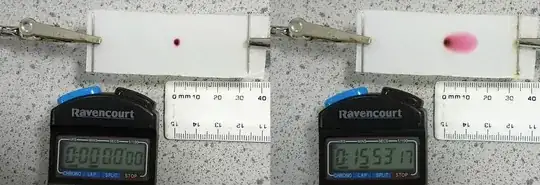We all know that the definition of a current is the amount of charge flowing per second, that is often expressed by the equation $i=dq/dt$. But is it possible to measure the speed of an electric current in m/s? And also how can we measure such speed?
4 Answers
As shown in other posts the calculated drift speed of electrons in a metal is "surprising" low, $\approx 10 \,\rm \mu m \,s^{-1}$.
A simple demonstration can be set up to illustrate this low speed for coloured ions rather than electrons which are difficult to observe directly.
A filter paper is placed on a microscope slide and saturated with ammonium hydroxide.
A crystal of potassium permanganate is placed in the centre of the filter paper and it starts to dissolve in the ammonium hydroxide and the intense purple, negatively charged, manganate (VII) ion can be seen around the crystal.
If a voltage, $\approx 100\,\rm V$, is applied across the filter paper the intense purple colour (negative manganate (VII) ions) can be seen to migrate towards the positive end of the filter paper.
As can be seen from the two stills the drift speed is of the order of $15\,\rm mm / 16\, min \approx 16\,\mu m\,s^{-1}$.
- 104,498
If you mean by speed of electrons then, drift velocity is $$v=\frac{I}{nqA}$$ where $n$ denotes charge density of a particular substance (it's $8.5\times 10^{28} \text{m}^{-3}$ for copper as an example), $q$ as you may already know denotes charge of electrons ($1.602\times 10^{-19} \text{C}$), $A$ denotes the cross sectional area of a substance. And $I$ denotes the electric current.
Let's do an example where speed of electrons is found in an copper wire
$A=\frac{1}{1000000}\text{m}^2$
$n= 8.5×10^{28}\text{m}^{-3}$ and say we set $I=1\text{ A}$,
$q=1.602\times 10^{-19}\text{C}$.
Putting it in expression of drift velocity gives you the speed of electrons as $0.07$ mm/sec which you can convert into metres.
- 42,352
- 668
Let's say that you have a wire with cross section $S$. Denote by $v$ the average speed of charge carriers, whose density is $n$. Assuming also that each charge carrier has charge $e$, it is clear that \begin{equation} J=e v n S \end{equation} From here you can find $v$
- 568
From two other answers you know how the speed, $v$, of the charge carriers is related to the current, provided that you know $n$, the number of charge carriers per unit volume.
The Hall effect gives you an independent way to measure $v$. Send a current in the $z$ direction through a cuboid of the conducting material of dimensions $\Delta x \times \Delta y \times \Delta z$. Apply a known magnetic field $B$ to the cuboid in the $x$ direction. A 'transverse' pd $\Delta V_y$ will appear across the faces separated by $\Delta y$, given by $$\Delta V_y = Bv \Delta y.$$ Hence $v$, though there are various practical difficulties to be dealt with.
- 37,325
